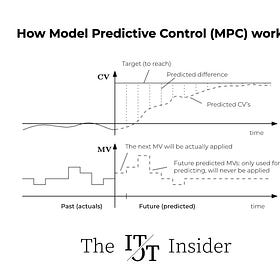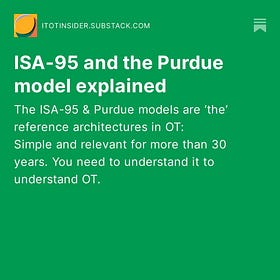Let’s talk Manufacturing Execution Systems (MES)
In this article, we do a deep dive into the world of MES, MOM and related concepts. They all have a distinct role to play, especially in Manufacturing plants.
Last week, Bram talked about his early experiences in starting and scaling his Digital Transformation Journey at a global food producer. We briefly touched the term MES or Manufacturing Execution System. In this article, we do a deep dive into this and related concepts.
In manufacturing, we frequently encounter terms like MES (Manufacturing Execution System), MOM (Manufacturing Operations Management), Historians, along with a host of other acronyms. More recently data platforms, data hubs and Unified Namespace are added to this list.
While these systems each have distinct roles, their functions often overlap, and their scope can vary significantly depending on the organization or even who you ask.
In this article, we’ll break down each of these systems to clarify their differences and outline the key capabilities you can typically expect from each.
What is a MES?
A Manufacturing Execution System (MES) is designed to manage and monitor real-time production processes on the shop floor. It serves as a vital link between enterprise-level systems like ERP and the process automation layer.
To better understand MES, it’s useful to place it within the broader manufacturing context, specifically the ISA-95 model. ISA-95 is an international standard for integrating enterprise and control systems, organized into layers that range from physical processes to business applications.
In a factory without MES, there is often an ERP system (Level 4) that manages business processes and a separate physical factory process with its automation layer (Levels 1 and 2). These two systems are not interconnected; information between them is typically managed through mountains of paperwork and manual administration.
MES operates at Level 3, bridging the gap between shop floor operations and business processes. Its goal is to eliminate the paper work and the inaccuracies and delays associated with it. MES provides higher data accuracy, real-time insights, and reduces time spent on administrative tasks. By physically connecting the previously isolated operational network with the office network, MES builds a bridge between the IT organization and the OT organization.
The typical capabilities of an MES application include:
Production Order Management: Manages the scheduling and execution of production orders to provide real-time status updates of process orders during execution into the ERP system and offer guidance to operators to ensure efficient resource utilization and adherence to production plans.
Recipe Management: Ensures consistency and accuracy in product formulations. These are usually interfaced with ERP systems and are enhanced with process-specific details, such as target process parameters and specific batch parameters.
Inventory and Traceability Tracking: Provides real-time visibility into raw materials, work-in-progress (WIP), and finished goods, ensuring comprehensive traceability throughout the production process. This also typically includes recording of waste and rework.
Performance Analysis: Monitors operational performance to calculate real-time Overall Equipment Efficiency (OEE), and analyzes production data to optimize manufacturing operations and identify areas for improvement.
Quality Management: Integrates quality control execution directly into production workflows. This is particularly useful for automatic quality sample triggers that need to be done in specific phases of the process order (at start of a batch, at the end of a batch, every x hours…)
Energy Management: Tracks energy consumption across various stages of the production process, helping to identify inefficiencies, reduce energy costs, and improve sustainability by optimizing energy usage.
Shift handover and operator logbook: Ensures smooth shift transitions by recording key events and updates providing a clear digital communication trail between operators on different shifts and team leaders.
Data historian / Data Platform
Another capability to consider is data collection and acquisition. This capability is typically brought through an historian (or alike data platform), a data logger responsible for storing operational data, particularly time-series data like sensor readings (temperature, pressure, flow rates, etc.). This data enables deeper insights into process performance and supports better decision-making.
Some vendors include an historian in their MES offerings, while others offer it as a separate component. Review our article on OT data here to read more about industrial data platforms.
An important side note: we also see more and more vendors moving away from the ‘classical’ historian approach towards a central data broker (such as the Unified Namespace) or a central data hub (for example built upon a GraphQL layer to allow object modeling). In this case the MES application interacts with the broker/hub instead of the historian. We also have an article on UNS you might want to review.
MES vs. MOM
MES and MOM (Manufacturing Operations Management) are sometimes used interchangeably, but they represent different scopes within manufacturing management. In the strict sense MES specifically focuses on the execution phase of production, managing real-time process activities and resource utilization. In this context, MES can be considered a component of MOM. MOM is a broader concept that extends beyond the execution phase and encompasses the entire spectrum of manufacturing operations such as Connected worker tools, maintenance management (CMMS – Computerized Maintenance Management System), and quality management (QMS – Quality Management System or LIMS – Laboratory Information Management System) and others.
The specific capabilities and scope of each system can vary across organizations: quality testing, data collection, energy management, real-time dashboarding etc... Other organizations may have different dedicated systems as part of the MoM landscape as illustrated by the below example of a system-specific capability mapping.*
*Capability mapping is an important step in digital transformations. While this example illustrates how to map capabilities per system, and can be a useful tool for visualizing data flows and for training, capability mapping on enterprise level can also be built following the E2E supply chain processes (Forecast-to-stock, …) In a future article we will zoom in deeper in concrete examples of capability mapping
Complexity of MES integration
The complexity of integrating an MES lies in bridging the gap between two distinct worlds: the IT and OT networks. This integration demands efficient collaboration between IT and OT teams, ensuring they speak the same language and work towards a unified goal. For the integration to deliver value, seamless data exchanges are crucial.
Consider the example of recording a material transaction, such as the automatic dosing of sugar into a mixer. Without an MES, this transaction would be monitored by a sensor connected to the automation layer. An operator would then manually capture this data—often on paper—and later enter the consumed amounts into the ERP system, potentially hours or even days later.
With MES, the process is streamlined: inventory, recipes, and work orders are interfaced from the ERP to the MES layer. The MES then relays relevant process order details to the automation layer. When an operator initiates the order through the automation layer, the MES records the material consumed, the source tank, and the batch number. This information is then confirmed back to the ERP in real-time, updating inventory data immediately.
When implemented correctly, this results in an accurate, real-time match between the physical reality on the shop floor and the theoretical inventory in the ERP system. However, achieving this seamless integration requires more than just technology—it involves meticulous coordination of people and processes. Proper training, clearly defined procedures, and diligent management are essential to ensure smooth interactions across all systems. Without careful planning and execution, many things can go wrong and the effectiveness of the MES integration can be compromised.
Join Us Next Time: Navigating the Critical Balance in MES Implementation
Whether discussing MES or the broader scope of MOM, it's evident that these Level 3 systems play a crucial role in bridging the gap between business applications and the shop floor. They enhance data accuracy, provide real-time insights, and improve operational efficiency.
In one of our next articles, we’ll dive deeper into what happens when the delicate balance between people, processes, and technology is disrupted during digital transformation projects, revisiting Bram’s first MES deployment experience, as introduced in the previous article. Through concrete examples, we'll explore the challenges that emerge when this critical harmony is compromised and how it can significantly impact the effectiveness of your MES deployment. As we’ve discussed, achieving a seamless, real-time match between shop floor reality and ERP data requires more than just technology—it demands meticulous coordination of people and processes. When this balance is disturbed, the consequences can be severe, potentially undermining the entire integration effort.
Stay tuned as we continue to unravel these challenges and provide practical insights to help you navigate the complexities of digital transformation in manufacturing.
About our ‘let’s talk about’ articles
In our 'Let's Talk About' series, we dive into the critical technologies that enhance modern manufacturing efficiency. You might also want to review this previous article on Model Predictive Control (MPC), our article how sensor data works or Purdue/ISA95:
Let's talk about Model Predictive Control (MPC)
In today's tech talks, it seems like Artificial Intelligence (AI) steals the show. We're talking about machine learning, big language models, and the like. And we're all for it! We see the magic in math and the power of algorithms that turn the data in your
The IT and OT view on data - Part 1 on Industrial Data Platforms
In our relentless efforts in bringing together the IT and OT world, it is now time to see if we can find some common ground when it comes to storing data at scale.
ISA-95 and the Purdue model explained
OT has a different perspective than IT on the world. The world of manufacturing isn’t virtual, it’s real, with ‘stuff’, sensors, actuators and control systems. This also brings additional complexity when describing this system. How do you describe an architecture that mixes reactors, sensors, real-time control systems, MES and ERP without getting lost?








